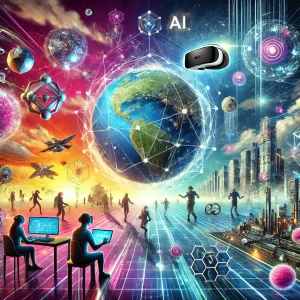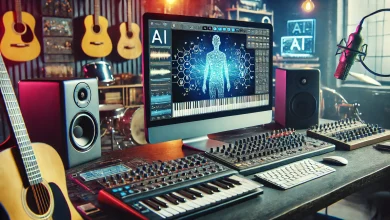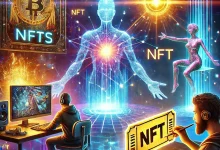The Evolution of the Metaverse: Key Developments Shaping 2025
The Evolution of the Metaverse: Key Developments in 2025
The concept of the metaverse, a collective virtual shared space that blends augmented reality (AR), virtual reality (VR), and the internet, continues to revolutionize digital interaction. In 2025, this transformative technology is experiencing exponential growth, reshaping industries and everyday life. This article delves into the key developments shaping the metaverse and explores its future potential.
1. Enhanced Virtual Reality Experiences
Virtual reality technology has made significant strides, becoming more immersive and accessible than ever. In 2025, VR headsets feature:
- Hyper-realistic Graphics: Advances in rendering technology and hardware have resulted in near-photorealistic visuals, making virtual worlds indistinguishable from reality.
- Improved Wearability: Lightweight and ergonomic designs have transformed bulky headsets into sleek, comfortable devices suitable for prolonged use.
- Haptic Feedback Enhancements: Haptic gloves and full-body suits now allow users to “feel” virtual environments, adding a new dimension to immersion.
These innovations have propelled the adoption of VR in gaming, education, and even therapy, broadening its appeal.
2. Expansion of Social Metaverse Platforms
Social interaction within the metaverse has become a cornerstone of its appeal. Platforms like Meta’s Horizon Worlds, Decentraland, and Roblox are evolving to accommodate:
- Larger Communities: Seamless scalability enables millions of users to interact in real-time without lag or disconnection.
- Advanced Avatars: AI-driven customization tools offer avatars with lifelike expressions and gestures, enhancing communication.
- Virtual Events: From concerts to corporate meetings, virtual gatherings are more engaging, offering 3D spatial audio and real-time collaboration tools.
These advancements are blurring the lines between physical and digital socialization.
3. The Rise of Virtual Economies
The metaverse in 2025 is home to thriving virtual economies, driven by blockchain technology and non-fungible tokens (NFTs). Key highlights include:
- Digital Ownership: NFTs allow users to buy, sell, and trade unique virtual assets like real estate, art, and collectibles.
- Play-to-Earn Gaming: Gamers earn real-world income through in-game achievements and asset trading.
- Metaverse Businesses: Virtual storefronts and services cater to a digital-first audience, creating opportunities for entrepreneurs.
These developments have positioned the metaverse as a legitimate financial ecosystem.
4. Integration with Artificial Intelligence (AI)
AI is a driving force behind the evolution of the metaverse, enhancing user experiences and platform capabilities. In 2025, AI contributes through:
- Intelligent NPCs: Non-player characters powered by AI offer realistic interactions, serving as guides, educators, or companions in virtual spaces.
- Dynamic World Generation: AI algorithms create procedurally generated landscapes and scenarios tailored to individual users.
- Personalized Experiences: AI analyzes user behavior to curate content, recommend events, and optimize engagement.
This symbiosis between AI and the metaverse ensures an ever-evolving, user-centric environment.
5. Cross-Platform Accessibility
Breaking barriers between platforms is a priority for metaverse developers. Key innovations include:
- Device Compatibility: Users can seamlessly transition between VR headsets, smartphones, PCs, and AR glasses.
- Unified Accounts: Single-login systems allow for interoperability across multiple metaverse platforms.
- Cloud-Based Streaming: High-performance cloud computing reduces the need for expensive hardware, making the metaverse more inclusive.
These developments democratize access, fostering widespread adoption.
6. Real-World Applications
Beyond entertainment, the metaverse in 2025 has practical applications in various industries:
- Healthcare: Virtual reality is used for remote consultations, surgical training, and mental health therapy.
- Education: Immersive classrooms offer interactive lessons, virtual field trips, and collaborative projects.
- Real Estate: Virtual property tours and architectural visualization are redefining the housing market.
- Retail: Brands use virtual storefronts to create engaging shopping experiences.
The metaverse is proving to be more than a novelty, becoming a vital tool for productivity and innovation.
7. Privacy and Ethical Challenges
As the metaverse expands, so do concerns about data privacy and ethical usage. Key issues include:
- Data Security: Protecting user data from breaches and unauthorized access is paramount.
- Digital Identity: Ensuring that avatars and accounts are safeguarded against theft or misuse.
- Content Moderation: Addressing harassment, misinformation, and other harmful behaviors within virtual spaces.
Developers and policymakers are working collaboratively to establish regulations and best practices to ensure a safe and inclusive metaverse.
8. Sustainability and Energy Efficiency
The metaverse’s growth has sparked concerns about its environmental impact. In 2025, solutions include:
- Energy-Efficient Servers: Green data centers powered by renewable energy minimize carbon footprints.
- Eco-Friendly Practices: Companies are adopting sustainable methods for hardware production and recycling.
- Awareness Campaigns: Users are educated on minimizing energy consumption during metaverse activities.
These efforts align the metaverse with global sustainability goals.
9. Future Outlook
Looking ahead, the metaverse’s evolution is poised to redefine digital interaction further. Emerging trends include:
- Brain-Computer Interfaces (BCIs): Direct neural interaction with the metaverse could enable thought-driven navigation and communication.
- Hyper-Realistic Environments: Advances in simulation and physics engines will make virtual worlds indistinguishable from reality.
- Global Collaboration: The metaverse will foster cross-cultural exchange and international collaboration like never before.
The possibilities are boundless, limited only by imagination and innovation.
Conclusion
The metaverse in 2025 is a vibrant, dynamic space that blends technology, creativity, and human connection. From enhanced VR experiences and thriving virtual economies to real-world applications and sustainability efforts, the metaverse is shaping the future of digital interaction. As it continues to evolve, its impact on society, culture, and industry will be profound. Are you ready to step into the future of the metaverse?







